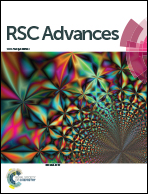Gold–chitin–manganese dioxide ternary composite nanogels for radio frequency assisted cancer therapy
Abstract
Gold nanoparticles (Au-NPs) based chitin-MnO2 ternary composite nanogels (ACM-TNGs) were prepared by the regeneration of chitin along with MnO2 nanorods (5–20 nm) and the incorporation of 10 nm sized Au-NPs to make “ACM-TNGs”. They were characterized with FT-IR, TG, and UV spectroscopy. The SEM showed spindle shaped 200 nm sized chitin–MnO2 nanogels (chitin–MnO2 NGs), whereas ACM-TNGs had spindle sizes of 220 nm. The ACM-TNGs were compatible up to 1 mg mL−1 and showed uptake into L929, HDF, MG63, T47D and A375 cell lines without affecting the cellular morphology. ACM-TNGs showed conductivity, and heating under a radio frequency (RF) source at 100 W for 2 min. They also showed the ability to kill breast cancer cells under RF radiation at 100 W for 2 min, when compared with the chitin–MnO2 NGs. The RF assisted ablation of breast cancer cells was confirmed by a live/dead assay. These results suggests that ACM-TNGs could be useful for the RF assisted cancer cells ablation with minimal toxicity compared with MnO2 nanorods.


 Please wait while we load your content...
Please wait while we load your content...